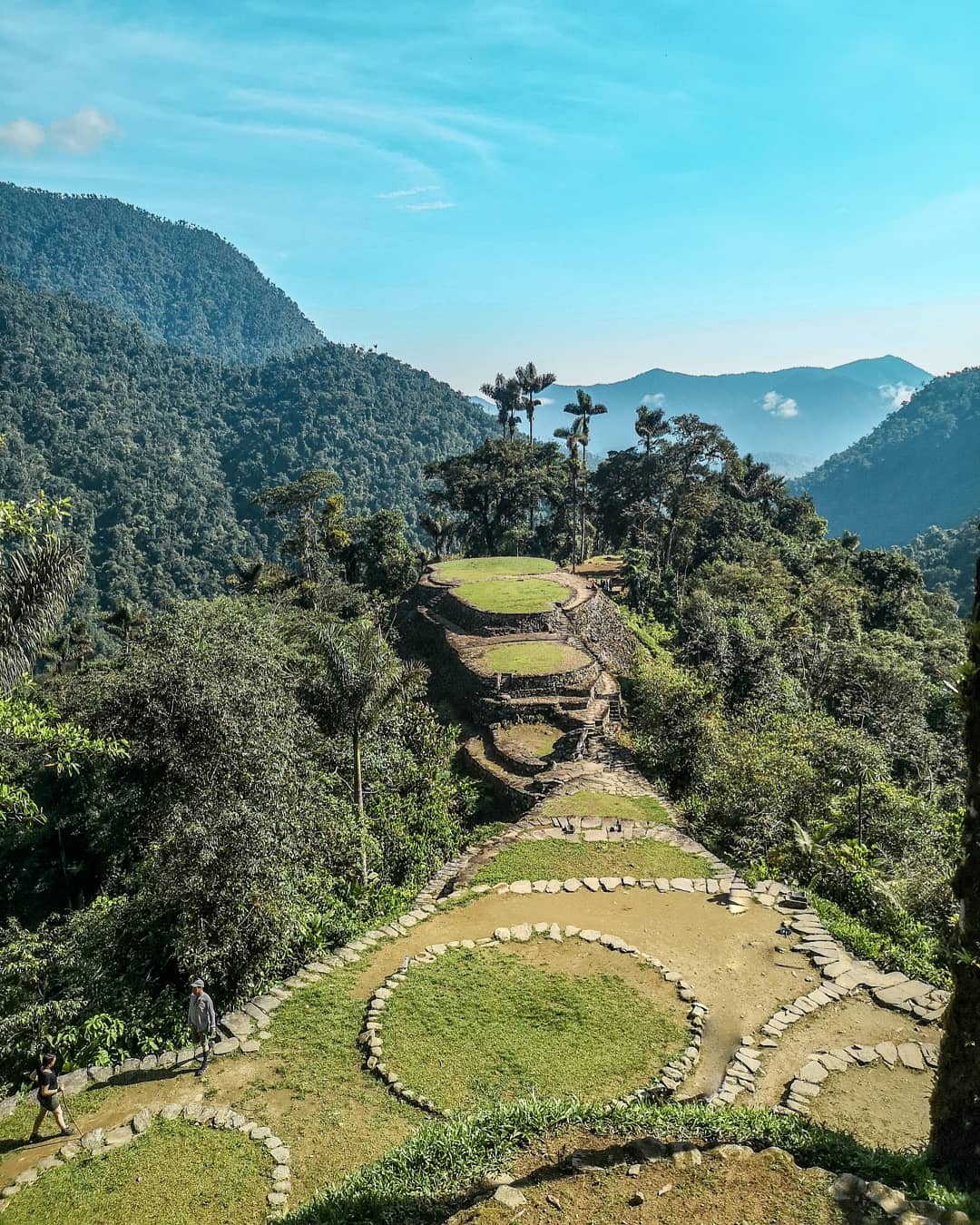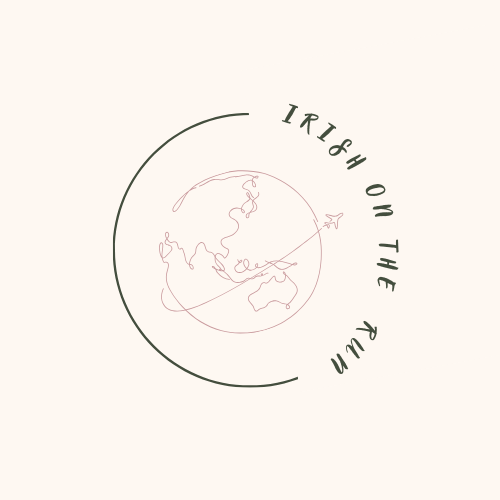The Lost City trek- finding La Ciudad Perdida

The Lost City trek had been high on my list of must dos in Colombia ever since I heard about it a few months before. A four day trek in the Sierra Nevada mountains to discover an ancient abandoned city that disappeared into the jungle around the time of the Spanish conquest sounded a bit of me.
The Lost City was rediscovered in 1972 and is so deep in the Sierra Nevada mountains it can only be reached by foot, or by helicopter we found out on day 3. The ironic thing is the indigenous people knew it was there all along. The city was built by the Tayronas back in 800 AD and its thought between 4000 and 12,000 people in La Ciudad Perdida.
Only some of the city has been excavated as the indigenous people do not want anymore deforestation that would be required to expose more of the city.
The hike:

The hike is a total of 70 km over 4 days. They say its a total distance of 48 km but that has been measured as the crow fly’s so we measured it and it is just over 70 km of hiking. It is mainly over a dusty dirt track that weaves its way up and down the Sierra Nevada mountains.
There isn’t much of the trek that is on the flat. It’s a tough hike and on day 1 there isn’t much coverage from the sun but it’s doable for nearly everyone once you are half fit. There are plenty of fruit and water breaks along the way and you’re really well feed on the trip. I came back with more snacks in my bag than I started with and pretty sure I gained weight on a four day hike if that’s even possible! Each day we headed off between 6 and 6.30 am and had a wake up call at 5 am for breakfast. Each day was an average of 20 km except for the first day. It’s broken up well with a long lunch break where we got to swim or chill out for about 2 hours so we felt refreshed after lunch, ready to smash out another 10 km. There is a translator at the front and a guide and a guide assistant at the back so people can walk at their own pace which was really good. Our translator Maria is incredibly fit and we were hard pushed to stick with her at the front.



One day one we got picked up from our hostel in Tayrona at 11 am and were brought to the little village, Manely, where we had lunch first. After a decent feed and a briefing about the tour we headed off from the village and were lured into a false sense of security with the path starting off relatively flat. After this few km on the flat we had a steep incline to a view point and water melon. We covered about 11 km on the first day and arrived to the first camp before 5 pm.
Sleeping at the camps:
I was pleasantly shocked at how nice the camps were and that we had proper beds with mosquito nets and blankets. At closer inspection the sheets looks extremely clean. I slept in my sleeping bag liner just to be safe as I had heard stories of bed bugs. All the camps had showers, toilets, plenty of sinks, wifi which you could pay a euro for, a shop to buy snacks and beers and free filtered water. I slept surprisingly well every night and after some other multi day hikes my expectations were rock bottom so the camps seemed like 5 star to me. All the camps were very similar.

Food:
The food was incredible throughout! All meals from lunch on day one to lunch on the last day were included. We had cooks who traveled with us the whole way and were the real heroes getting up at 3 am every day to make breakfast for us before running ahead to the next camp to prepare lunch. The catered for vegetarians really well or any other dietary needs. We were actually over fed for the four days. There were snack breaks along the way for juice and fresh fruit. Before dinner we had popcorn two of the evenings and hot chocolate. I came back with a bag of snacks I had eaten on the trek so definitely no need to bring any snacks with you.

Culture:
Along the way we met members of the indigenous tribes who live in the Sierra Nevada mountains. This for me made the experience. It was so interesting learning about their way of life. They are completely self sufficient and produce all their own clothes, food and built their houses from natural materials around them. The only thing they go to Santa Marta for is fish and sea shells to make a powder with which they form a paste with the coco leaves. They chew the coco leaves all day for energy.




Many of the indigenous do not speak Spanish, they speak a native language. Our guide was so knowledgeable and we learnt so much about their traditions and way of life. The girls are eligible for marriage after their second menstruation so as you can imagine they had huge families as they start so young. I met a 15 year old girl that had three children. The women have a much shorter life expectancy as they stay indoors where they burn a fire all day. The men outlive the women by 20 years or more due to the women dying of respiratory conditions. I wonder if they knew the link between the smoke inhalation and significantly shorter lie expectancy, something I never asked.


The indigenous noticed back in the 90’s that the snow wasn’t lasting as long on the top of the mountains and called the BBC to come so they could broadcast the message to us outside of the tribe that we were taking too much from the earth and that it was getting sick. Even then, without science they knew that climate change was happening and they could visibly see the impact of it.
Then again in 2009 they called the BBC again, they couldn’t understand why nothing had changed and why their message had been ignored so the Kogis made a documentary. They wanted to demonstrate the reality of environmental pollution in their physical environment and to show how easily critical interconnections within the natural world can be damaged or destroyed.
I found this part absolutely fascinating how they have maintained their culture and an isolate existence since the Spanish conquest.


The Lost City:

On day 3 we rose early to start the hour walk to the Lost City and climb the 700 and something steps to the ancient site. Bring your passport, they give you an extra stamp if you’re into collecting passport stamps. The city itself is amazing, the views from the top are magnificent. We were so lucky with the weather, previously it had been overcast which was great as it wasn’t so hot hiking but on the third day we had clear skies and great views of the city below and mountains around.

We spend a few hours around the city, taking it in and then meeting some of the indigenous who live at the site. The children were running around and some asked for sweets. It’s not a great idea to give them candy as it roots their teeth and it’s not a diet they have been raised on. They are really shy people.



Our translator Maria asked one of the young girls how old she was and she scratched her head looking confused, she replied they don’t count in years, the count in moons. I would say the girl was no older than 16. One of the guys was ill so had to be air lifted via helicopter out. I’d say the they got to see some incredible views from above.


The mosquitoes at the lost city are another breed. They bite through clothes but wont touch you if you’re wearing enough DEET. My arse got bitten several times as it was the only place I wasn’t covered in a layer of DEET. I got 98% DEET in a specialist outdoor shop. The stuff is lethal and burns holes through bags and flip flops but no mosquito will touch you.
It took 3 days to get to the lost city and a day and a half to get back. Day 2 and day 4 are definitely the most challenging days.
Tour operator:
We went with Expoturs and they were incredible. The guide Gabrielle and translator Maria were amazing. They are the cheapest group too but not by much. The groups all do the same thing really so it doesn’t really matter who you book with. I paid exactly €300 for the four days which included everything and they dropped us off at our hostel in Santa Marta after. You can do the tour over 5 days but really most people are able to manage it over 4 days as the only difference is you stay an extra night at the camp we have a break in on the last day. The distance isn’t evenly spread out over the 5 days.
Tips:
- No need for snacks, they feed you enough.
- Bring DEET.
- Bring long pants and jumper for the evening, it gets cold.
- Bring as little as possible as you’ve to carry it so lighter the better.
- Nothing drys here with the humidity to have a dry pair of clothes and a wet pair.
- Loads of sun cream and a hat, it gets very hot.
It was one of the best things I’ve done during my 5 months of traveling and will remain in the top ten things I’m fairly sure. We met great people in our groups and the other groups who I kept meeting along the way in Colombia.
Related Posts
How to plan a trip to the Amalfi Coast: 7 of the best places to visit on your Amalfi adventure
Planning a trip to Italy’s colourful Amalfi Coast seaside towns? This guide will take…
5 January 2024The Ulmitate Guide to Capri: Where to eat, stay, drink and sunbath
A jewel of southern Italy, the island of Capri is famous for many reasons. It…
5 January 2024

